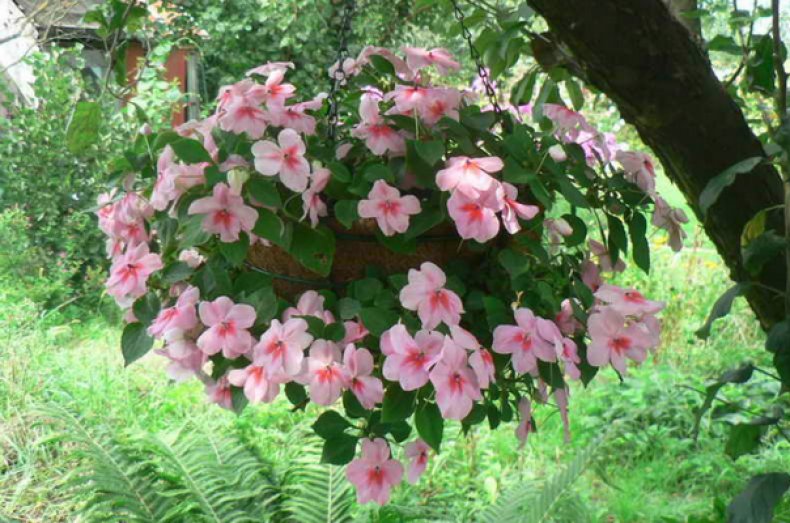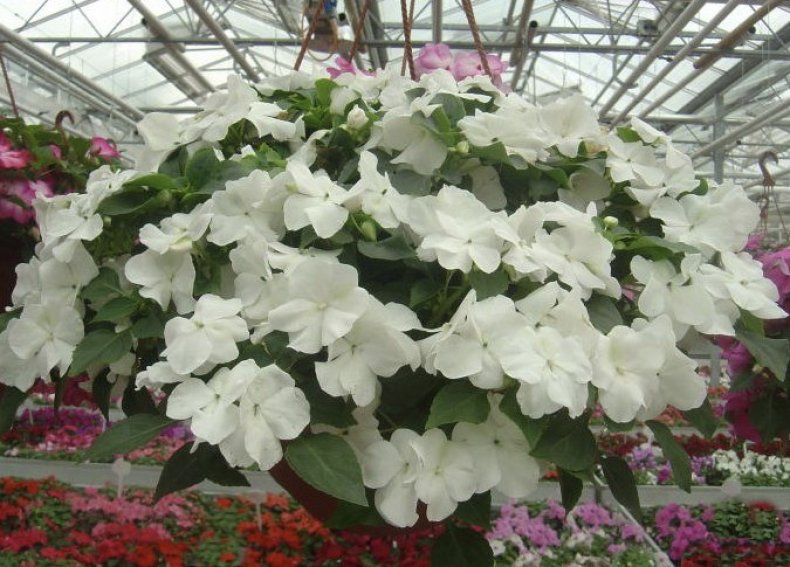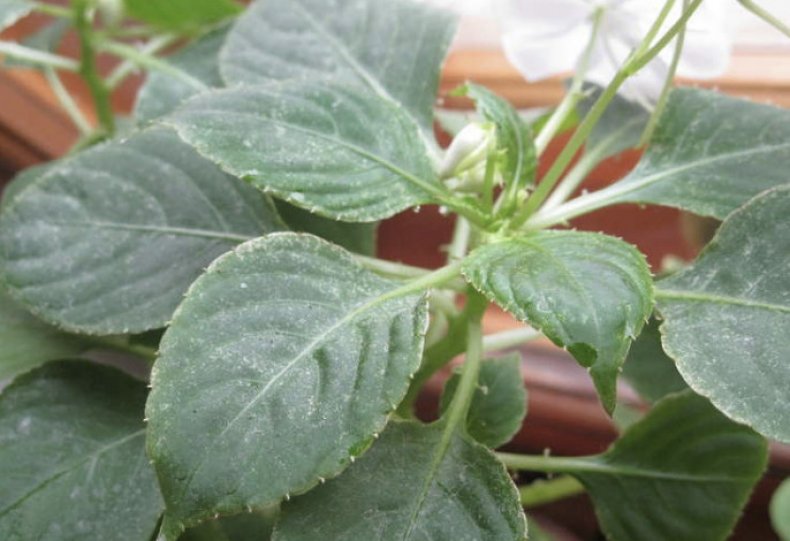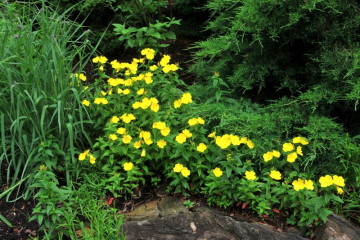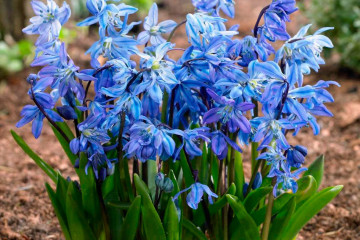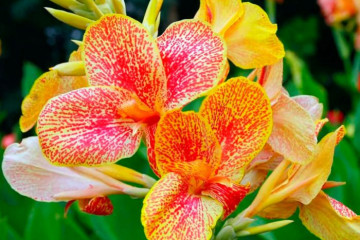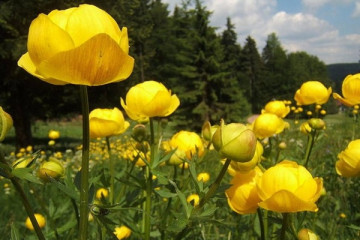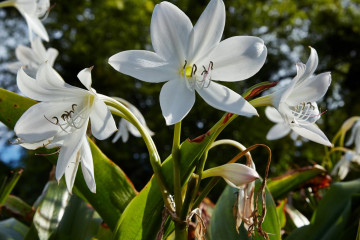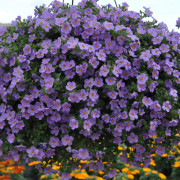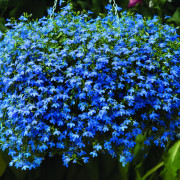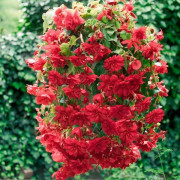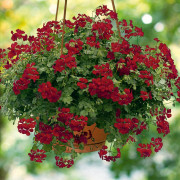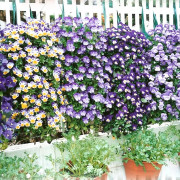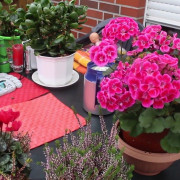Ampel impatiens - flower, planting and care
Content:
Impatiens is distinguished by beautiful bright colors. The plant gained its fame due to the fact that it can be used to make original flower arrangements, both in the garden and at home. Even a novice gardener can plant a plant, because this flower is not the most whimsical to care for. This article explains what an ampelous impatience is and how to care for it.
Impatiens ampelous: description of the plant
Impatiens is a herbaceous shrub with large, erect stems. The plant's nutrition comes from a large rhizome. Shoots grow quickly and form a spherical bush up to 45 cm high. If the humidity is high, small granules appear on the stems, similar to grains of salt.
The petals are attached to the stems on small petioles and have an oval or ovoid shape. The size of each petal is approximately 9-14 cm. The edges of the petals are covered with small teeth, and on the surface there is a relief pattern of veins. The leaves are mostly green in color, but sometimes have a purple hue.
The first flowers begin to grow in early spring and replace each other until mid-winter. The color of the leaves can be bright red, pink, emerald, purple, blue, lilac, orange. There are also species with the usual 5-petal flowers in the shape of an open bell. Now on the market there are many varieties of velvety-looking plants whose flowers look like a small rose.
Planting and leaving
Plants do not require complex maintenance. This unpretentious flower gets used to environmental conditions well, blooms for a long time. But like every other decorative flower, it needs some care. Next, the necessary care for the impatience will be considered.
How to care for a young plant
Planting and caring for an ampelous impatience consists of elementary stages: proper planting, feeding and sufficient watering.
Moisture is one of the most important processes in growing a flower. At a temperature of 25 ° C, it should be moderate. But, the higher the temperature in the room, the more water vapor must be in the air, so the stems of the impatiens are rinsed. This action is very important for the development of the plant. Watering the bush should also be done sparingly, but the soil in pots or pots should not dry out. In summer, the volume of water for a flower increases.
These flowers perceive a certain shade well, but when the sun shines, the petals become juicier, and a huge number of buds appear on the bushes. They are not afraid of direct sunlight, and in dark rooms, flowers stretch out and crumble. You can plant in hanging pots, deep and not very large garden and balcony boxes and vases with a volume of 2 liters or more.
When the bushes begin to grow and bloom quickly, they must be fed. Several times a month during watering, it is necessary to dilute mineral fertilizers in water, which are intended for flowering balcony and garden plants.
Pests, diseases and prevention
The most common ailments that can cause tangible harm to the plant:
- Balsam mosaic. Fresh leaves deteriorate and yellow specks form on them. Over time, the spots grow and already affect the stems of the bush. If the disease is not treated in a timely manner, then the plant will stop blooming and die. It makes no sense to carry out treatment, so you need to immediately pinch off the affected parts. In the case of this disease, prevention is of great importance: only constant spraying of the plant with an insecticide will help prevent the development of the disease.
- Gray rot. Brown spots form on the petals and shoots of the flower, which over time turn into gray fungal areas. Affected plants mostly die. Causes of the disease: watering with contaminated water or the use of tools that have not been cleaned. Methods of struggle: preventive care, as well as strict adherence to the time of watering and fertilization. If signs of infection with the disease were noticed, it is urgent to remove the affected parts of the flower and spray it with foundation.
- Bacteriosis Watery specks form on the leaves and shoots that grow quickly. If the infection is ignored, the flower will die. Causes of the disease: a very hot place of detention and a lack of nutritional components. Ways to fight: you need to cut off the affected parts and spray with Bordeaux liquid.
- Powdery mildew. A light bloom forms on the petals of an ampelous plant. The cause of the disease: strong temperature changes, insufficient air in the room, poor quality feeding. Methods of struggle: you need to cut off the painful petals and spray the flower with fungicides (experienced gardeners advise the drug Bayleton).
Ampel impatience
The most popular ampelous varieties:
Impatiens ampelous Highlight F1 Deep Orange
Home planting benefits:
- professional impatience for hanging baskets, to be sown outdoors;
- forms a continuous blooming ball;
- very long flowering plant: from June to frost in October-November;
- perfectly tolerates rains and bad weather;
- it is recommended to grow in places with diffused sunlight.
What to consider when landing:
- germination: 10-15 days at 20-25 ° C;
- seedlings: 7-8 weeks at 18-20 ° C;
- disembarkation to a permanent place: first decade of June;
- beginning of flowering: 15-16 weeks.
Impatiens ampelous acrobat
Another name for this old variety is Vanka wet. It is so called due to the fact that small drops of moisture appear along the edge of the petals. Gardeners also call it pelargonium balsam. Flowers of a bright shade stand out against the background of marsh leaves.
This variety is a perennial. The bush is quite branched and has thick stems. Marsh or red-brown petals of small diameter, oval. Flowers of white, red or light pink tones are located at the ends of the branches. If you adhere to the rules of care and planting, then this plant will bloom for a whole year, and in warm weather they can be used as decoration for flower beds.
The plant does not like bright direct sun, it is advisable to choose a small partial shade. With diffused rays, the flowers become brighter. Supports or wings give the plant protection against rainfall. The beautiful shape of this species looks good in hanging planters. This is a highly branching bushes, strewn with flowers with shoots of 25 cm.
Impatiens ampelous is almost not capricious in care, however, it requires care. You can not put the flower in direct sunlight, otherwise it will quickly die. This plant is quite popular on the market, experienced gardeners recommend using it as a decoration in pots.
